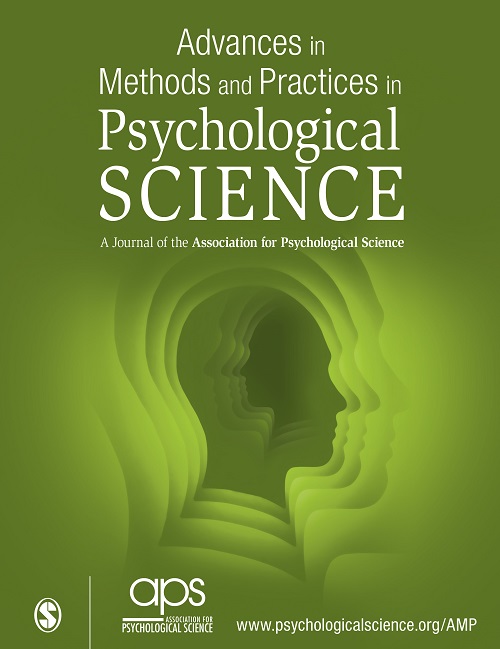方差的贝叶斯重复测度分析:一种在JASP中实现的更新方法
IF 13.4
1区 心理学
Q1 PSYCHOLOGY
Advances in Methods and Practices in Psychological Science
Pub Date : 2023-04-01
DOI:10.1177/25152459231168024
引用次数: 1
摘要
方差分析(ANOVA)被广泛用于评估一个或多个实验(或准实验)操作对连续结果的影响。传统上,方差分析是使用p值以频率分析的方式进行的,但已经提出了贝叶斯替代方案。假设所提出的贝叶斯方差分析是以其频繁度对应物为模型的,人们可能会惊讶地发现,当设计涉及多个重复测量因素时,两者可以得出非常不同的结论。我们用受试者内两因子实验的真实数据集来说明这种差异。对于该数据集,频率分析和贝叶斯方差分析的结果在数据方差的主要影响因素方面存在分歧。这种分歧的原因是,频繁度分析和所提出的贝叶斯方差分析使用了不同的模型规范。正如目前所实施的那样,所提出的贝叶斯方差分析假设影响的大小没有个体差异。我们怀疑,这种假设对大多数分析师来说既不明显,也不可取,因为它在大多数应用程序中都是站不住脚的。我们在这里认为,贝叶斯方差分析应该进行修正,以考虑到个体差异。默认情况下,我们建议使用标准的常客模型规范,但讨论了最近提出的替代方案,并就如何选择合适的模型规范提供了指导。最后,我们讨论了修订后的模型规范对先前发表的贝叶斯方差分析结果的影响。本文章由计算机程序翻译,如有差异,请以英文原文为准。
Bayesian Repeated-Measures Analysis of Variance: An Updated Methodology Implemented in JASP
Analysis of variance (ANOVA) is widely used to assess the influence of one or more experimental (or quasi-experimental) manipulations on a continuous outcome. Traditionally, ANOVA is carried out in a frequentist manner using p values, but a Bayesian alternative has been proposed. Assuming that the proposed Bayesian ANOVA is closely modeled after its frequentist counterpart, one may be surprised to find that the two can yield very different conclusions when the design involves multiple repeated-measures factors. We illustrate such a discrepancy with a real data set from a two-factorial within-subject experiment. For this data set, the results of a frequentist and Bayesian ANOVA are in a disagreement about which main effect accounts for the variance in the data. The reason for this disagreement is that frequentist and the proposed Bayesian ANOVA use different model specifications. As currently implemented, the proposed Bayesian ANOVA assumes that there are no individual differences in the magnitude of effects. We suspect that this assumption is neither obvious to nor desired by most analysts because it is untenable in most applications. We argue here that the Bayesian ANOVA should be revised to allow for individual differences. As a default, we suggest the standard frequentist model specification but discuss a recently proposed alternative and provide guidance on how to choose the appropriate model specification. We end by discussing the implications of the revised model specification for previously published results of Bayesian ANOVAs.
求助全文
通过发布文献求助,成功后即可免费获取论文全文。
去求助
来源期刊
CiteScore
21.20
自引率
0.70%
发文量
16
期刊介绍:
In 2021, Advances in Methods and Practices in Psychological Science will undergo a transition to become an open access journal. This journal focuses on publishing innovative developments in research methods, practices, and conduct within the field of psychological science. It embraces a wide range of areas and topics and encourages the integration of methodological and analytical questions.
The aim of AMPPS is to bring the latest methodological advances to researchers from various disciplines, even those who are not methodological experts. Therefore, the journal seeks submissions that are accessible to readers with different research interests and that represent the diverse research trends within the field of psychological science.
The types of content that AMPPS welcomes include articles that communicate advancements in methods, practices, and metascience, as well as empirical scientific best practices. Additionally, tutorials, commentaries, and simulation studies on new techniques and research tools are encouraged. The journal also aims to publish papers that bring advances from specialized subfields to a broader audience. Lastly, AMPPS accepts Registered Replication Reports, which focus on replicating important findings from previously published studies.
Overall, the transition of Advances in Methods and Practices in Psychological Science to an open access journal aims to increase accessibility and promote the dissemination of new developments in research methods and practices within the field of psychological science.

 求助内容:
求助内容: 应助结果提醒方式:
应助结果提醒方式:


